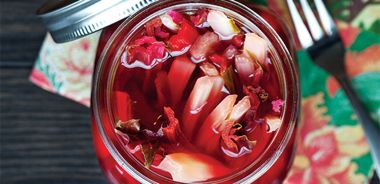Pickled Chard Stems

Vinegary chard stems make a powerful addition to sandwiches, scrambled eggs, or an antipasto platter. They’re ready to enjoy after sitting for 24 hours and will keep for one week.
Stems from 1 large bunch Swiss chard
1/2 cup (125 mL) water
1/3 cup (80 mL) cider vinegar or rice vinegar
1 tsp (5 mL) mustard seeds
1 tsp (5 mL) sugar
1/2 tsp (2 mL) salt
2 garlic cloves, peeled
Cut stems so they are 4 in (10 cm) or less in length. Place stems in steamer basket and steam just until tender crisp.
In small saucepan, bring water, vinegar, mustard seeds, sugar, and salt to a boil. Simmer until sugar and salt are dissolved.
Place chard stems and garlic in wide mouth jar and pour in vinegar mixture. Let cool and then fasten the lid. Refrigerate for at least 24 hours before serving.
Serves 8.
Each serving contains: 10 calories; 0 g protein; 0 g total fat; 2 g total carbohydrates (1 g sugars, 0 g fibre); 176 mg sodium
Good for you: There are two primary varieties of Swiss chard on store shelves: one with multicoloured stems and veins, called rainbow chard, and another with white stems and veins. Both provide a nutritional bonanza, including impressive amounts of beta carotene. In the body, beta carotene can be converted to vitamin A to improve eye and immune health.
source: "Hearty Winter Greens", alive #375, January 2014





